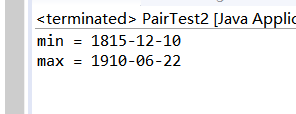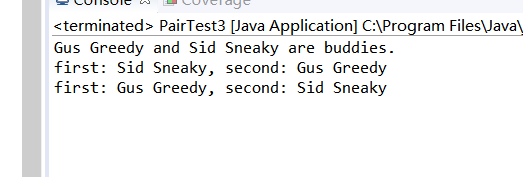|
项目 |
内容 |
|
这个作业属于哪个课程 |
<任课教师博客主页链接> https://www.cnblogs.com/nwnu-daizh/ |
|
这个作业的要求在哪里 |
<作业链接地址> https://www.cnblogs.com/nwnu-daizh/p/11815810.html |
|
作业学习目标 |
|
第一部分:总结第八章关于泛型程序设计理论知识(25分)
泛型:(参数化类型)在定义类、接口和方法时,通过类型参数指示将要处理的对象类型。(ArrayList类)。
泛型类:具有一个或多个类型变量的类,即创建用类型作为参数的类。
class Generics<K,V> K,V是类的可变类型参数
泛型类可以有多个类型变量。
类的类型变量用于指定方法的返回类型以及域、局部变量的类型。
泛型方法:用于指定方法参数或返回值为泛型类型,留待方法调用时确定。
泛型方法可以声明在泛型类中,也可以声明在普通类中。
泛型接口:
定义: public interface IPool <T>
{
T get();
Int add(T ,t);
}
实现:
public class GenericPool <T> implements IPool <T>
{....}
public class GenericPool implents IPool <Account>
{....}
泛型变量的限定:
泛型变量的上界:
public class NumberGeneric <T extends Number>
NumberGeneric类所能处理的泛型变量类型和Number有继承关系。
extends(类型范围限定)关键字所声明的上界既可以是一个类,也可以是一个接口。
<T extends Bounding Type >表示T应该是绑定类型的子类型。、
一个类型变量或通配符可以有多个限定,限定类型用“&”分割。
<T extends Comparable & Serializable>
泛型变量的下界:
List <? super CashCard> cards=new ArrayList<T>();
通过使用super关键字可以固定泛型参数的类型为某种类型的超类。
当希望一个方法的参数限定类型时,通常可以使用下限通配符
Public static <T> void sort(T[] a,Comparator<? super T> c)
{...}
通配符类型:
“?”表明参数类型可以是任何一种类型
通配符一般有以下用法:
单独的“?”用于表示任何类型。
? extends type 表示有上界
? super type 表示有下界
通配符的类型限定:
Pair<? extends Employee>
Pair<? super Manager>
无限定的通配符:Pair<?>
泛型类的约束和局限性:
不能用基本类型实例化类型参数
运行时类型查询只适用于原始类型
不能抛出也不能捕获泛型类实例
参数化类型的数组不合法
不能实例化类型变量
泛型类的静态上下文中类型变量无效
注意擦除后的冲突
泛型类型的继承规则:
Java中的数组是协变的.
例: Integer扩展了Number ,那么在要求Number[]的地方完全可以传递或者赋予Integer[], Number[]也是Integer[]的超类型.
Employee是Manager的超类,因此可以将一个Manager[]数组赋给一 个类型为Employee[]变量:
Manager[] managerBuddies = {ceo, cfo};
Employee[] employeeBuddies = managerBuddies;
但这一原理不适用域泛型类型。
Java中泛型类不具协变性.如果能够将List<Integer>赋给List<Number>.
那么下面的代码就允许将非Integer的内容放入List<Integer> :
List<Integer> li = new ArrayList<Integer>();
List<Number> In = li;
In.add(new Float(3.1415));
泛型类可扩展或实现其它的泛型类。
例如,
ArrayList<T>类实现List<T>接口.
意昧着一个ArrayList<Manager>可以被转换为一个List<Manager>.
第二部分:实验部分
实验1:测试程序1(6分)
编辑、调试、运行教材311、312页代码,结合程序运行结果理解程序;
在泛型类定义及使用代码处添加注释;
掌握泛型类的定义及使用。
Pair.java
package pair1;
/**
* @version 1.00 2004-05-10
* @author Cay Horstmann
*/
public class Pair<T> //定义泛型类,Pair类引入了一个类型变量T,T是类的可变类型参数
{
private T first;
private T second;
public Pair() { first = null; second = null; }
public Pair(T first, T second) { this.first = first; this.second = second; }
public T getFirst() { return first; }
public T getSecond() { return second; }
public void setFirst(T newValue) { first = newValue; }
public void setSecond(T newValue) { second = newValue; }
}
PairTest1.java
package pair1;
/**
* @version 1.01 2012-01-26
* @author Cay Horstmann
*/
public class PairTest1
{
public static void main(String[] args)
{
String[] words = { "Mary", "had", "a", "little", "lamb" };
Pair<String> mm = ArrayAlg.minmax(words);//调用方法并将返回值赋给泛型类对象变量mm
System.out.println("min = " + mm.getFirst());
System.out.println("max = " + mm.getSecond());
}
}
class ArrayAlg
{
/**
* Gets the minimum and maximum of an array of strings.
* @param a an array of strings
* @return a pair with the min and max values, or null if a is null or empty
*/
public static Pair<String> minmax(String[] a)//返回类型为Pair<String>
{
if (a == null || a.length == 0) return null;//数组为空引用或空数组
String min = a[0];
String max = a[0];
for (int i = 1; i < a.length; i++)
{
if (min.compareTo(a[i]) > 0) min = a[i];//两个字符串的比较
if (max.compareTo(a[i]) < 0) max = a[i];
}
return new Pair<>(min, max);
}
}

小结:
泛型:在定义类、接口和方法时,通过类型参数指示将要处理的对象类型。
泛型类:具有一个或多个类型变量的类,即创建类型作为参数的类。
class Generics<K,V> K,V都是类的可变类型参数
类的类型变量用于指定方法的返回类型和域、局部变量的类型。
实验1:测试程序2(6分)
编辑、调试运行教材315页 PairTest2,结合程序运行结果理解程序;
在泛型程序设计代码处添加相关注释;
了解泛型方法、泛型变量限定的定义及用途。
Pair.java
package pair2;
/**
* @version 1.00 2004-05-10
* @author Cay Horstmann
*/
public class Pair<T> //定义泛型类,Pair类引入了一个类型变量T,T是类的可变类型参数
{
private T first;
private T second;
public Pair() { first = null; second = null; }
public Pair(T first, T second) { this.first = first; this.second = second; }
public T getFirst() { return first; }
public T getSecond() { return second; }
public void setFirst(T newValue) { first = newValue; }
public void setSecond(T newValue) { second = newValue; }
}
PairTest2.java
package pair2;
import java.time.*;
/**
* @version 1.02 2015-06-21
* @author Cay Horstmann
*/
public class PairTest2
{
public static void main(String[] args)
{
LocalDate[] birthdays =
{
LocalDate.of(1906, 12, 9), // G. Hopper
LocalDate.of(1815, 12, 10), // A. Lovelace
LocalDate.of(1903, 12, 3), // J. von Neumann
LocalDate.of(1910, 6, 22), // K. Zuse
};
Pair<LocalDate> mm = ArrayAlg.minmax(birthdays);
System.out.println("min = " + mm.getFirst());
System.out.println("max = " + mm.getSecond());
}
}
class ArrayAlg
{
/**
Gets the minimum and maximum of an array of objects of type T.
@param a an array of objects of type T
@return a pair with the min and max values, or null if a is null or empty
*/
public static <T extends Comparable> Pair<T> minmax(T[] a) //将T限制为实现了Comparable接口的类,Comparable接口本身就是一个泛型类型
{
if (a == null || a.length == 0) return null;//空引用或空数组
T min = a[0];
T max = a[0];
for (int i = 1; i < a.length; i++)
{
if (min.compareTo(a[i]) > 0) min = a[i];
if (max.compareTo(a[i]) < 0) max = a[i];
}
return new Pair<>(min, max);
}
}

小结:
泛型方法:用于指定方法参数或返回值为泛型类型,留待方法调用时确定,可以声明在泛型类里,也可以声明在普通类里;
泛型变量的上界:extends关键字实现,
extends(类型范围限定)关键字所声明的上界既可以是一个类,也可以是一个接口。
泛型变量的下界:通过使用super关键字可以固定泛型参数的类型为某种类型的超类。
当希望一个方法的参数限定类型时,通常可以使用下限通配符
public static <T> void sort(T[] a,Comparator<? super T> c)
{...}
实验1:测试程序3(6分)
用调试运行教材335页 PairTest3,结合程序运行结果理解程序;
了解通配符类型的定义及用途。
Pair.java
package pair3;
/**
* @version 1.00 2004-05-10
* @author Cay Horstmann
*/
public class Pair<T> //定义泛型类,Pair类引入了一个类型变量T,T是类的可变类型参数
{
private T first;
private T second;
public Pair() { first = null; second = null; }
public Pair(T first, T second) { this.first = first; this.second = second; }
public T getFirst() { return first; }
public T getSecond() { return second; }
public void setFirst(T newValue) { first = newValue; }
public void setSecond(T newValue) { second = newValue; }
}
PairTest3.java
package pair3;
/**
* @version 1.01 2012-01-26
* @author Cay Horstmann
*/
public class PairTest3
{
public static void main(String[] args)
{
var ceo = new Manager("Gus Greedy", 800000, 2003, 12, 15);
var cfo = new Manager("Sid Sneaky", 600000, 2003, 12, 15);
var buddies = new Pair<Manager>(ceo, cfo);
printBuddies(buddies);//调用printBuddies方法
ceo.setBonus(1000000);
cfo.setBonus(500000);
Manager[] managers = { ceo, cfo };
var result = new Pair<Employee>();
minmaxBonus(managers, result);
System.out.println("first: " + result.getFirst().getName()
+ ", second: " + result.getSecond().getName());
maxminBonus(managers, result);
System.out.println("first: " + result.getFirst().getName()
+ ", second: " + result.getSecond().getName());
}
public static void printBuddies(Pair<? extends Employee> p)//任何泛型Pair类型,它的类型参数是Employee的子类,Pair<Manager>是Pair<? extends Employee>的子类型
{
Employee first = p.getFirst();
Employee second = p.getSecond();
System.out.println(first.getName() + " and " + second.getName() + " are buddies.");
}
public static void minmaxBonus(Manager[] a, Pair<? super Manager> result)//限定了Manager的所有超类型
{
if (a.length == 0) return;
Manager min = a[0];
Manager max = a[0];
for (int i = 1; i < a.length; i++)
{
if (min.getBonus() > a[i].getBonus()) min = a[i];
if (max.getBonus() < a[i].getBonus()) max = a[i];
}
result.setFirst(min);
result.setSecond(max);
}
public static void maxminBonus(Manager[] a, Pair<? super Manager> result)
{
minmaxBonus(a, result);
PairAlg.swapHelper(result); //swapHelper方法捕捉通配符类型
}
// can't write public static <T super manager> . . .
}
class PairAlg
{
public static boolean hasNulls(Pair<?> p)//无限定的通配符,测试一个pair是否包含一个null引用
{
return p.getFirst() == null || p.getSecond() == null;
}
public static void swap(Pair<?> p) { swapHelper(p); }//交换成队元素信息
public static <T> void swapHelper(Pair<T> p)//swapHelper是一个泛型方法,具有固定的Pair<?>类型参数,参数T捕捉通配符
{
T t = p.getFirst();
p.setFirst(p.getSecond());
p.setSecond(t);
}
}
Employee.java
package pair3;
import java.time.*;
public class Employee
{
private String name;
private double salary;
private LocalDate hireDay;
public Employee(String name, double salary, int year, int month, int day)
{
this.name = name;
this.salary = salary;
hireDay = LocalDate.of(year, month, day);
}
public String getName()
{
return name;
}
public double getSalary()
{
return salary;
}
public LocalDate getHireDay()
{
return hireDay;
}
public void raiseSalary(double byPercent)
{
double raise = salary * byPercent / 100;
salary += raise;
}
}
Manager.java
package pair3;
public class Manager extends Employee
{
private double bonus;
/**
@param name the employee's name
@param salary the salary
@param year the hire year
@param month the hire month
@param day the hire day
*/
public Manager(String name, double salary, int year, int month, int day)
{
super(name, salary, year, month, day);
bonus = 0;
}
public double getSalary()
{
double baseSalary = super.getSalary();
return baseSalary + bonus;
}
public void setBonus(double b)
{
bonus = b;
}
public double getBonus()
{
return bonus;
}
}

小结:
通配符类型:
“?”表明参数类型可以是任何一种类型
通配符一般有以下用法:
单独的“?”用于表示任何类型。
? extends type 表示有上界
? super type 表示有下界
通配符的类型限定:
Pair<? extends Employee>
Pair<? super Manager>
无限定的通配符:Pair<?>
实验2:结对编程练习(32分)
import java.util.ArrayList;
import java.util.Scanner;
interface GeneralStack<T>{
public T push(T item);
public T pop();
public T peek();
public boolean empty();
public int size();
}
class ArrayListGeneralStack implements GeneralStack{
ArrayList list=new ArrayList();
public String toString() {
return list.toString();
}
public Object push(Object item) {
if (list.add(item)){
return item;
}
else
{
return false;
}
}
public Object pop() {
if (list.size()==0){
return null;
}
return list.remove(list.size()-1);
}
public Object peek() {
return list.get(list.size()-1);
}
public boolean empty() {
if (list.size()==0){
return true;
}
else {
return false;
}
}
public int size() {
return list.size();
}
}
class Car{
private int id;
private String name;
public String toString() {
return "Car [" +"id=" + id +", name=" + name + ']';
}
public int getId() {
return id;
}
public void setId(int id) {
this.id = id;
}
public String getName() {
return name;
}
public void setName(String name) {
this.name = name;
}
public Car(int id, String name) {
this.id = id;
this.name = name;
}
}
public class Main {
public static void main(String[] args) {
Scanner a=new Scanner(System.in);
while (true){
String s=a.nextLine();
if (s.equals("Integer")){
System.out.println("Integer Test");
int count=a.nextInt();
int popcount=a.nextInt();
ArrayListGeneralStack array = new ArrayListGeneralStack();
for (int i=0;i<count;i++){
System.out.println("push:"+array.push(a.nextInt()));
}
for (int i=0;i<popcount;i++){
System.out.println("pop:"+array.pop());
}
System.out.println(array.toString());
int sum=0;
int size=array.size();
for (int i=0;i<size;i++){
sum+=(int)array.pop();
}
System.out.println("sum="+sum);
System.out.println("interface GeneralStack");
}
else if (s.equals("Double")){
System.out.println("Double Test");
int count=a.nextInt();
int popcount=a.nextInt();
ArrayListGeneralStack array = new ArrayListGeneralStack();
for (int i=0;i<count;i++){
System.out.println("push:"+array.push(a.nextDouble()));
}
for (int i=0;i<popcount;i++){
System.out.println("pop:"+array.pop());
}
System.out.println(array.toString());
double sum=0;
int size=array.size();
for (int i=0;i<size;i++){
sum+=(double)array.pop();
}
System.out.println("sum="+sum);
System.out.println("interface GeneralStack");
}
else if (s.equals("Car")){
System.out.println("Car Test");
int count=a.nextInt();
int popcount=a.nextInt();
ArrayListGeneralStack array = new ArrayListGeneralStack();
for (int i=0;i<count;i++){
int id=a.nextInt();
String name=a.next();
Car car = new Car(id,name);
System.out.println("push:"+array.push(car));
}
for (int i=0;i<popcount;i++){
System.out.println("pop:"+array.pop());
}
System.out.println(array.toString());
if (array.size()>0){
int size=array.size();
for (int i=0;i<size;i++){
Car car=(Car) array.pop();
System.out.println(car.getName());
}
}
System.out.println("interface GeneralStack");
}
else if (s.equals("quit")){
break;
}
}
}
}

实验总结:(15分)
经过一周的学习,理解掌握了泛型类的定义与使用,泛型方法的声明与使用;泛型接口的定义与实现;最后了解泛型程序设计及其用途,通配符的使用。通过验证实验,更深的学习了泛型程序<T>的使用。但是本周的结对编程题,感觉有难度,有些写不出来,还是借鉴了别人的代码。通过理解这些程序,但更大程度的理解了泛型程序设计的应用,更加理解了本周所学知识。



 浙公网安备 33010602011771号
浙公网安备 33010602011771号